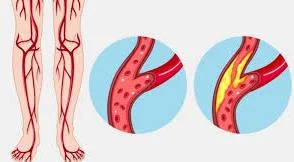Occlusive
Arterial Disease
Definition
It is a condition
characterized by blocking of the arterial lumen due to any cause.
Aetiology
1.Burger’s disease.
2.Raunaud’s disease.
3.Tobacco chewing o smoking.
4.Diabetes mellitus.
5.Heredity.
6.Working with vibrating tools.
7.Trauma.
8.Ateriosclerosis.
9.Atherosclerosis.
Clinical
features
|
Feature |
Manifestations |
|
Claudication |
.Cramps in the calves during walking. .The person is forced to stop due to the pain. .The Cramps are relieved by rest. |
|
Rest pain |
.It is seen when the extent of the block is greater than that
causing Claudication. .There is pain in the legs even when the person is resting. .Sleeplessness due to pain. .The patient elevates his legs during sleep for obtaining relief
from pain. |
|
Nutritional changes |
.Loss of sensation in the toes. .Toes are hard and flaky. .Moistness between toes. .Thinning of leg and loss of hair from the leg. .Features of gangrene. |
Treatment
1.Any form of injury to the lower limb is
avoided, by adopting the following measures:-
. New footware isnot worn.
.Tight shocs or socks are not
worn.
.Hot water bag or bottle is not
used for fomentation.
. The leg is not tied tightly to
relieve pain.
.Toe-nails are not pared. They ar allowed to grow because they protect
the nail-bed.
.The nails are well cared for, preventing development of paronychia.
2.General care
.Tobacco is not used any form ,
such as smoking or chewing.
.Deep breathing exercises are
done to improve venous return through the deep veins.
.Long walks are taken at a slow
speed.
. Hypertension is treated ,if
any.
. The head end of the cot is
raised during sleep to improve blood
flow to the lower limbs.
.Diet rich in fats is avoided,
to reduce the risk of atherosclerosis.
.Vasodilators are avoided
because they may cause hypertension by dilating all the blood vessels in the
body.
3. prevention of infection
.Maintenance of hygiene.
.Control of diabetes mellitus, if any.
4.Surgical treatment: It is done depending
on the patient’s age, general condition, underlying cause and the prohnosis.
Various forms of surgical treatment are shown in the following table.
Surgical Treatment of
Arterial Occlusion
|
Surgery |
Features |
|
Thromboendarterectomy |
The thrombus and arteriosclerotic patch are removed using a ring
stripper passes through an incision in the arterial wall. Then the arterial
incision is repaired. |
|
Bypass graft |
The diseased segment of the artery is left undisturbed and a
segment of the patient’s saphenous vein removed surgically is sutured to the
artery at two points,one above the
level of the block and the other below the level of the block. |
|
Transluminal angioplasty |
If there is a stricture of the artery,a special type of ballon
catheter is passed into it through the femoral artery using sedinger
technique. Its passage is confirmed fluoroscopically. The balloon is inflated
when it lies in the part with the stricture. This results in stretching of the
stricture and its expansion. |
Preoperative Care
1.General care is taken as for any major
surgery.
2. The
patient is confirmed to be fit for anaesthesia and surgery.
3.Diabetes mellitus is controlled ,if any.
4.Any infection in the body is treated.
5.Four to fix units of blood are cross-matched with the patient’s blood
and kept ready for the surgery.
6.Antibiotics may be started
prophylactically.
7.Arterial radiography are kept ready and sent to the operation theater
with the patient.
8.If the patient is to undergo surgery on
the abdominal arteries, a catheter is passed before sending him to the
operation theatre.
Postoperative
care
1.The pulse and blood pressure are watched
carefully.
2.There may be drainage tube after leg
surgery. If it is present, it is cared for as discussed before.
3.The surgical wound and the drainage tube
are watched for haemorrhage and if it is present, the doctor is told about
immediately.
4. The part of the limb distal to the site of surgery is observed carefully for skin colour,
sensation,and arterial pulsations, and any abnormality is reported to the
doctor immediately.
5.Complete rest in bed is given for the
first 2 days. Then the patient is mobilized gradually.
6. Thrombosis of the graft is watched for,
because that would require a repeat surgery.
7.If the graft gets infected, secondary haemorrhage may occur. That needs
to be prevented, and if it does occur, to be treated energetically and early.
8.paralytic ileus after aortic surgery is
treated appropriately.







0 Comments